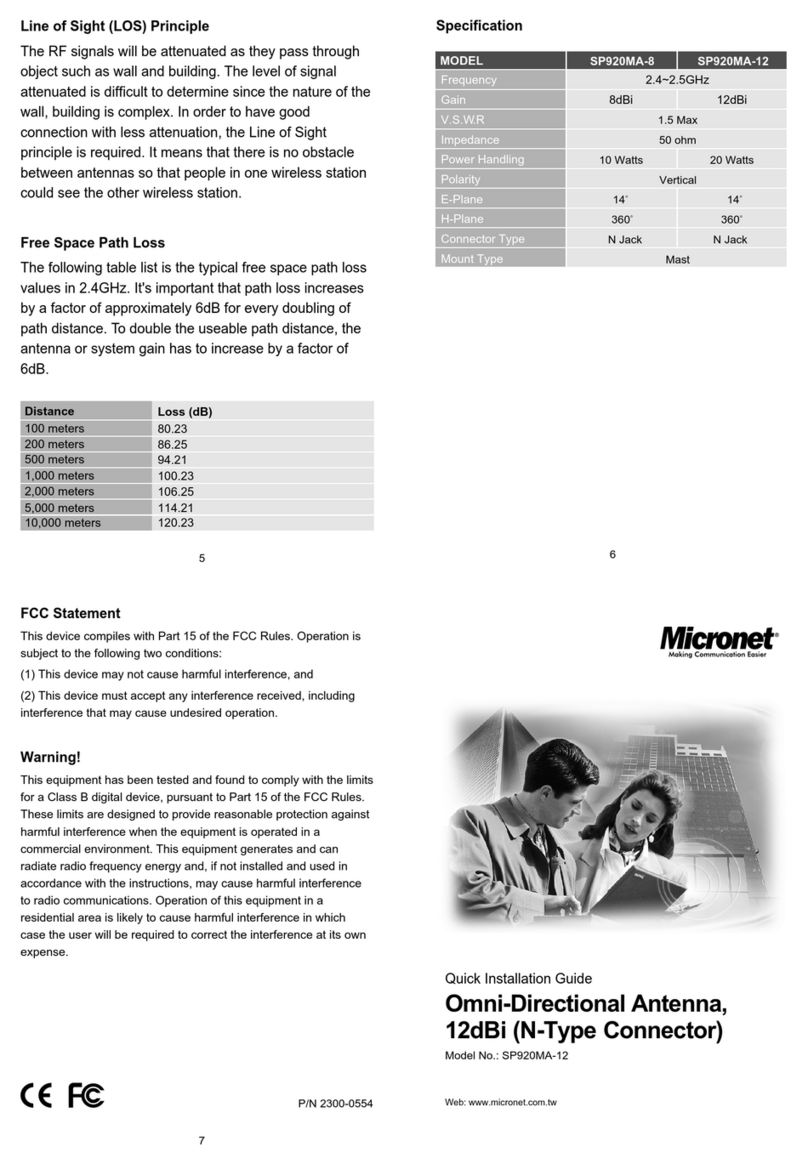The product specifications are subject to change without prior notice.
Specification
MODEL
GAIN
IMPEDANCE
POWER HANDLING
VSWR
POLARITY
E-PLANE
H-PLANE
CONNECTOR TYPE
SP920M
Y †b‹
ANTENNA TYPE o’“‹M†‹—‡…™‹”“ƒ‘
UP oŠ’˜
QNUZQ
QPP w
v‡—™‹…ƒ‘
QT †‡‰—‡‡
SVP †‡‰—‡‡
n HjackI
SIZE SNS ž SNS ž URNU …’ Hl ž w ž hI
MOUNT STYLE tš„‡ e“†
WEIGHT PNUU Ž‰
D. Antenna Installation Guide
Line of Sight (LOS) Principle
The RF signals will be attenuated as they pass through object
such as wall and building. The level of signal attenuated is
difficult to determine since the nature of the wall, building is
complex. In order to have good connection with less
attenuation, the Line of Sight principle is required. It means that
there is no obstacle between antennas so that people in one
wireless station could see the other wireless station.
Free Space Path Loss
The following table list the typical free space path loss values in
2.4GHz. It's important that path loss increases by a factor of
approximately 6dB for every doubling of path distance. To
double the useable path distance, the antenna or system gain
have to increase by a factor of 6dB.
Calculate the Distance
Here is the formula for quick calculation of wireless connection
distance in 2.4 GHz.
For example: Use 2x SP912 AP and 1x SP920DA (8dBi)
Directional Antenna &1x SP920MA (9dBi)
TX Power of SP912 =13 dB, RX Sensitivity of SP912 = -83 dB
Antenna gain: 8+9 =17 dB
Cable loss: 2 x 0.6 =1.2 dB
Where the x = (13+83+17-1.2-100)/6= 11.8/6 =1.96
The Max. Distance is 2^1.8 =3.8 KM
Distance l”˜˜ H†bI
100 meters XPNRS
200 meters
500 meters
1,000 meters
2,000 meters
5,000 meters
10,000 meters
XVNRU
QRPNRS
YTNRQ
QPPNRS
QPVNRU
QQTNRQ
Distance l”˜˜ H†bI
Distance (KM)= 2
TX Power + | RX Sensitive | + Antenna Gain - Cable Loss -100(dB)
6
X =
x
Quick Installation Guide
SP920M
Omni-directional Antenna , 9dBi with
N-Type Connector
http://www.micronet.com.tw
P/N: 2300-0034




















